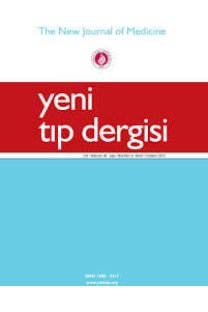Nüks lomber disk hernilerinde tedavi yaklaşımları
Management approach in relapsing lumbar disc hernia
___
- 1. Cinotti G, Roysam GS, Eisenstein SM, Postacchini F. Ipsilateral recurrent lumbar disc herniation. A prospective, controlled study. J Bone Joint Surg Br 1998;80(5):825-32.
- 2. Dvorak J, Gauchat MH, Valach L. The outcome of surgery for lumbar discherniation. A 4-17 years follow-up with emphasis on somatic aspects. Spine 1988;13:1418-22.
- 3. Jin J, Zhao ZG, Weng XS, Yang Xy, Zhao Y, Qiu GX. Reoperative treatment of lumbar disc herniation. Zhongguo Yi Xue Yuan Xue Bao 2005;27(2):160-4.
- 4. Loupasis GA, Stamos K, Katonis PG. Seven to 20 year outcome of lumbar discectomy. Spine 1999;24:2313-7.
- 5. Davis RA. A long term outcome analysis of 984 surgically treated herniated lumbar discs. J Neurosurg 1994;80:415-22.
- 6. Ozgen S, Naderi S, Ozek MM, Pamir MN. Finding and outcome revision lumbar disc surgery. J Spinal Disord 1999;12(4):287-92.
- 7. Finnegan WJ, Fenlin JM, Marvel JP, Nardini PJ, Rothman RH. Results of surgical intervention in the symptomatic multiple operated back patients: analysis of sixty seven cases followed three to seven years. J Bone Joint Surg Am 1979;61:1077-82.
- 8. OSullivan MG, Connoly AE, Buckley TF. Recurrent lumbar disc protrusion. Br J Neurosurg 1990;4:319-26.
- 9. Kim HJ, Chung S, Kim S, Shin H, Lee J, Kim S, et al. Influences of trunk muscles on lumbar lordosis and sacral angle. Eur Spine 2006;15:409- 14.
- 10. Evcik D, Yücel A. Lumbar lordosis in acute and chronic low back pain patients. Rheumatol Int 2003;23:163-5.
- 11. Cinotti G, Roysam GS, Eisenstein SM, Postacchini F. Ipsilateral recurrent lumbar disc herniation. J Bone Joint Surg Br 1998;80:825-32.
- 12. Resnick DK, Choudhri TF, Dailey AT. Guidelines for the performance of fusion procedures for degenerative disease of the lumbar spine. Part 8: lumbar fusion for disc herniation and radiculopathy. J Neurosurg Spine 2005;2:673-8.
- ISSN: 1300-2317
- Yayın Aralığı: 4
- Başlangıç: 2018
- Yayıncı: -
Mehmet İNCİ, Erkan YULA, Vijdan MOTOR KÖKSALDI, Mürsel DAVARCI, NİZAMİ DURAN, Çetin KILINÇ, Melek İNCİ
Abdullah BÜYÜKÇELİK, Yasemin CİHAN BENDERLİ, Abdülsamet ERDEN, Tuncay ASLAN, Hediye UĞUR, Zeki AKÇA, Hasan MUTLU
Esra KESKİN AKTEPE, Hasan KAFALI, Banu USLU AKÇAL, Aylin AYRIM AKER
Akut koroner sendromlu hastalarda kötü prognoz göstergesi olarak azalmıştır Hepsidin-25 Düzeyi
Hüseyin AYHAN, Nihal Akar BAYRAM, Telat KELEŞ, Tahir DURMAZ, Murat AKÇAY, Ekrem YETER, Tolga ÇİMEN, Mehmet DOĞAN, Engin BOZKURT
Koklear implantlıların konuşma performansı Üzerinde FM Sistem Etkisi
Geriatrik popülasyonda travma analizi: Kesitsel çalışma
Ceren TANRIKULU ŞEN, Mahmud Yusuf TANRIKULU
Ankara'da 0-5 yaş arası akut gastroenteritli çocuklarda rotavirus sıklığı
Ali Osman KÖKSAL, Tülin KÖKSAL
Eser SÖZMEN, Özlem DİLSİZ YILMAZ, Murat ULUKUş, Mine ERTEM, Utku ATEŞ
Hasan MUTLU, Zeki AKÇA, Yasemin CİHAN BENDERLİ, Abdülsamet ERDEN, Tuncay ASLAN, Hediye UĞUR, Abdullah BÜYÜKÇELİK
Katarak hastalarında monofokal ve akomodatif göz içi lensi kullanımının karşılaştırılması
